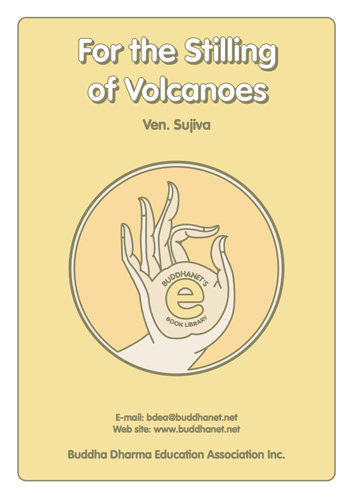 Top rated - eBook Library Top rated - eBook Library |

73_knowledges.pdfSeventy-Three Kinds of Knowledge3227 viewsVen. Nyanadassana, Bhikkhu
Since these knowledges are, as a Summary, very briefly stated,the present translation has explanatory notes in order to facilitate the reader understand them, at least intellectually, more easily. These explanations are based on the Pañisambhid -magga, the Visuddhi-magga and their corresponding Commentaries, and their references are clearly distinguished. The translation of each knowledge
is repeated in the Notes, in bold, for convenient reading.     
(4 votes)
|
|

volition.pdfVolition and the Law of Kamma2102 viewsWhat is kamma? The Buddha said: "Oh monks, it is volition that I call kamma." The popular meaning of kamma is action or doing, but as a technical term, kamma means volition or will. When you do something, there is volition behind it, and that volition, that mental effort, is called kamma. The Buddha explained that, having willed, one then acts through body, speech, and mind. Whatever you do, there is some kind of kamma, mental effort, will, and volition. Volition is one of the fifty-two mental states which arise together with consciousness.    
(4 votes)
|
|

bd_students.pdfBuddha Dhamma for University Students8503 viewsThis book is the results of two talks given by Ajahn Buddhadasa in January 1966 to students at Thammasat University, Bangkok. Ajahn Buddhadasa always has tried to set both young and old straight as to what Buddhism really teaches. He goes back to the original principles pointed out by the Buddha, explaining these simply and directly, and showing that their relevance is timeless.    
(13 votes)
|
|

prajparagen2.pdfThe Diamond Sutra7525 viewsThis sutra says, One should produce a heart without dwelling anywhere. The Sixth Patriarch, the Great Master Hui, heard that sentence and awakened to the Way. Any dwelling of the heart is no dwelling. Therefore, the Larger Chapters say, If one dwells in dharmas, he does not dwell in prajna paramita. If one does not dwell in dharmas, he dwells in prajna paramita. That is why every one of the Great Prajna assemblies begins with an explanation of not dwelling.    
(13 votes)
|
|

chandew.pdfThe Sweet Dews of Ch'an5386 viewsReverend Cheng Kuan
Ch'an or Zen is the outcome of meditation. There are two 'right'or 'highest' purposes of Ch'an. The first purpose is to achieve Dhyana. Dhyana is a combination of relaxation, concentration and calmness or tranquility. The second purpose is, using your very composed and tranquil mind, to observe clearly all the dharmas or phenomena externally and internally. As an outcome of Dhyana, you will be able to observe these phenomena very clearly because your mental mirror is very clear, for there are no more disturbances to veil it. Out of these observations will come Transcendental Wisdom, which in Sanskrit is called Prajna.    
(9 votes)
|
|

volcanos.pdfFor the Stilling of Volcanoes3460 viewsInsight Meditation as explained by Ven. Sujiva: It is not an task easy to approach such a profound topic as Insight Meditation in simple terms. But we have got to start somewhere. After some years of introducing this type of meditation, I still find that there is a lack of introductory material for those without knowledge of Buddhism. What is available is often extremely technical and loaded with ancient Indian terminology. There are some words in the English vocabulary which we can never hope to substitute perfectly. Even in this booklet I have used some English words such as 'conditioned' and 'suffering' which need special explanation when used in a Buddhist sense - but I have tried to come up with something easier to read and understand.    
(5 votes)
|
|

buddhinthai.pdfBuddhism in Thailand2564 viewsThis work presents facts and figures about the current condition of Buddhism in Thailand, historical background sketches of the establishment and growth of the Buddhist community in Thailand and information on Buddhist education in Thailand. (9-10 December, 2002).    
(6 votes)
|
|

bud-thailand.pdfBuddhism in Thailand3099 viewsThis is a history of Buddhism in Thailand - the Land of Yellow Robes. Its past and present. The Bhikkhu Sangha or the Order of monks: the two Sects or Nikayas. Wats (Temples) and Monks. The Laity. Buddhist organisations and the revival of Buddhism in Thailand.    
(6 votes)
|
|

tipitaka.pdfGuide to Tipitaka2659 viewsU KO Lay
The Guide to the Tipitaka is an outline of the Pali Buddhist Canonical Scriptures of Theravada Buddhism from Burma. This is a unique work, as it is probably the only material that deals in outline with the whole of the Pali Buddhist Tipitaka. The Tipitaka includes all the teachings of the Buddha, grouped into three divisions: the Soutane Patch, or general discourses; the Vane Patch, or moral code for monks and nuns; and the Abhidhamma Pitaka, or philosophical teachings. An excellent reference work which gives an overview of the Pali Buddhist texts.    
(6 votes)
|
|

nagarjuna.pdfThe Wisdom of Nagarjuna4327 viewsNagarjuna holds an almost unequaled place among the ranks of those Buddhist saints who expounded the teaching of the Buddha Sakyamuni for the benefit of the world. Nagarjuna revolutionized the interpretation of the doctrine of the Enlightened One which was current at his time and lent it a vitality and dynamism which has continued to sustain it even to our day among the votaries of the Mahayana. The revolution which Nagarjuna accomplished within the fold of Buddhism was not a radical departure from the original doctrine of the Buddha Sakyamuni. On the contrary, the adherents of the Madhyamaka school are undoubtedly justified in asserting that their interpretation represents the true import of the doctrine of the Buddha and the essence of Buddhism.    
(7 votes)
|
|
| 290 files on 29 page(s) |
 |
 |
 |
20 |  |
 |
 |
|
